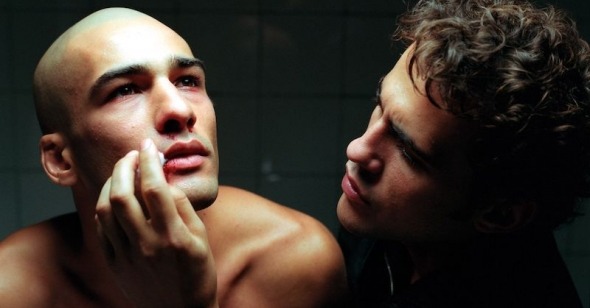Brothers' Peepers
by Michael Koresky
Three Dancing Slaves
Dir. Gaël Morel, France, TLA
Andre Techiné‘s Wild Reeds, still as urgently humane now as when it was released in 1995, has bestowed quite a legacy upon the new generation of French filmmaking. That film’s psychosexual and political tangles have slowly but surely created tendrils that have reached all the way through an entire decade’s worth of youth cinema. If Techiné’s tender evocation of adolescent confusion and the growing social and moral awareness of a group of young friends in the early Sixties during the ongoing French-Algerian conflict had any sort of direct effect on the national cinema, it has been in its ability to pass on its spirit of rebellion to its cast members, all of whom have surfaced in projects that seem to try to recreate their touchstone film’s almost untenable emotional and sociopolitical longing.
Elodie Bouchez quickly parlayed her wide-eyed restless youthfulness into The Dreamlife of Angels: Stephane Rideau, subsequently in Ozon’s Sitcom and Lifshitz’s Come Undone has since become something of a contemporary French film poster boy for outré sexual expression; and Gaël Morel, Wild Reeds' sexually confused protagonist François, rather quickly went on to direct his own feature films, the first of which, Full Speed, depicted a young love affair similarly breaking boundaries of sexual orientation and racial divides.
Yet what Techiné managed so effortlessly, Morel attempted to grasp with much less delicacy; his new film, “Three Dancing Slaves,” perhaps finds Morel more in his element. As a filmmaker, he seems to rely on “big themes”; and just as “Full Speed” dealt with racial equality, “Three Dancing Slaves” might as well have words like “tormented masculinity” emblazoned in fiery font across the screen throughout its duration. Yet Morel’s latest, as searching as it may be for a true emotional center, is directed with a newfound surety, its pulverizing forward motion very much keeping in tone with Morel’s branding-iron approach to filmmaking.
Ostensibly a glimpse at the disrupted lives of three young brothers under the thumb of their tyrannical father after the death of their mother, “Three Dancing Slaves” is more of a treatise on postadolescent male angst and the stranglehold of dominant masculine roles. Morel’s world, here a backwoods rural community in the Rhône-Alpes, is one comprised almost completely of men (the film’s first actual female character disrupts the film at minute 78 of its 90-minute running time) and in which there are few emotional outlets. The middle brother, scowling, head-shaven Marc (Nicholas Cazalé), has fallen in with the wrong crowd and become mixed up with some vicious local thugs; oldest Christophe (Rideau), recently released from prison, must try to readjust to the outside world as he earnestly takes a job at the local meat factory; and the youngest, indifferent teenager Olivier (Thomas Dumerchez), remains aloof while attempting to reconcile his own burgeoning sexual orientation.
As each brother deals with his psychological trauma within his own discreet chapter, he finds himself trying to hold on to the other two but feeling increasingly pulled in different directions, yet Morel’s film often seems somewhat disinterested, for better or for worse, in tidy narrative arcs and dramatic setups. There’s a palpable anger at its center, yet it’s never quite easy to locate its source. Marc, Christophe, and Olivier are seriously damaged goods, but can one blame nebulous plot details like parental dominance or economic desperation? More generalized, and effective, is Morel’s approach to sickly, sallow male codes of behavior, and the film is at its best when it creates an almost faceless environment of free-floating volatile machismo.
Where “Three Dancing Slaves” most excels and baffles is at pushing the homosocial into an almost abstract homoeroticism. The brothers seem more identifiable by the differences in their musculature than in their opaque expressions: Cazalé, who with his chrome dome and penetrating stare resembles a young, wiry Yul Brynner, swaggers through the film like a single-minded runway model; Rideau, stockier with a heart-shaped visage and heavier brow, seems more physically stable, sturdy enough to roll with life’s punches; and Dumerchez, a few years away from shedding his baby fat down to the rippling six-pack that seems to bless every young man in this region, is nonetheless covered in tattoos that make him seem disconcertingly older.
Morel’s constant surveying of the male body’s delights and horrors at times segues into empty rancid visual parallels, not the least in a very nasty bit of business with Marc’s dog, and even in the conveyer belt-like procession of meat-processing imagery from Christophe’s workaday hell. Yet the male body here is a source of pride and punishment, a compact utilitarian instrument given to sweaty fits of sexual energy. This is the main thrill of Three Dancing Slaves (its translated title named after the gyrating, free-form Capoeira street dancing practiced by some of the characters that originated in slavery): it elevates (or lowers) middle-class drudgery into a soft-core fantasia. The impression one leaves the theater with has less to do with the family’s economic burden than it does with the odd glimpse of pube-trimming or ass-shaving. A randy Techiné disciple, Gaël Morel lets sociological discourse take a backseat to his voyeuristic urge. Its lingering money shot, of the three brothers sleeping peacefully and naked, their bodies languidly entwined, cocks hanging out, slowly pans over to show the father glowering at them from across the darkened room as he smokes a cigarette. From whose point of view is this no-frills homoerotic longing meant to derive? Morel doesn’t seem to care, as long as we look.
[This article originally appeared on indieWire.]
